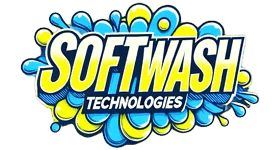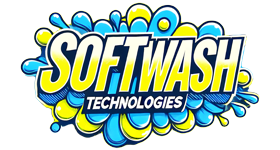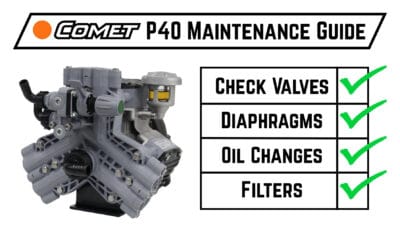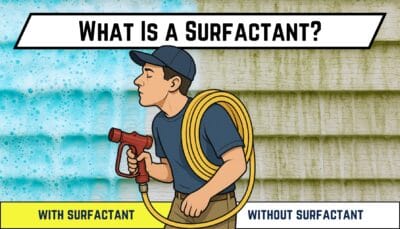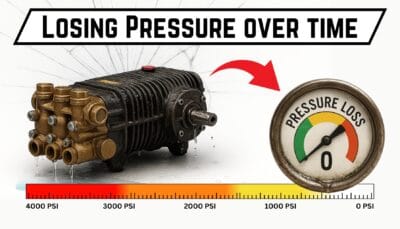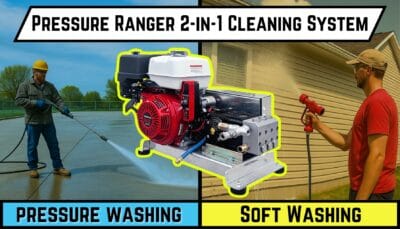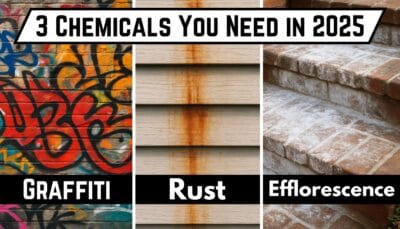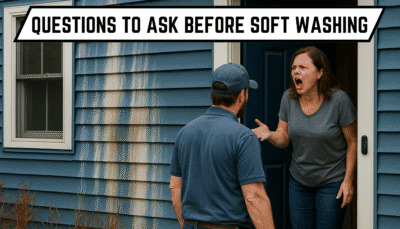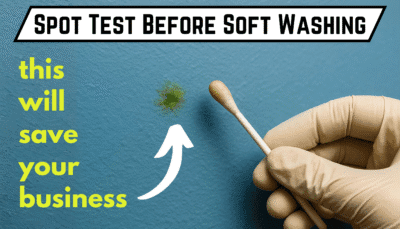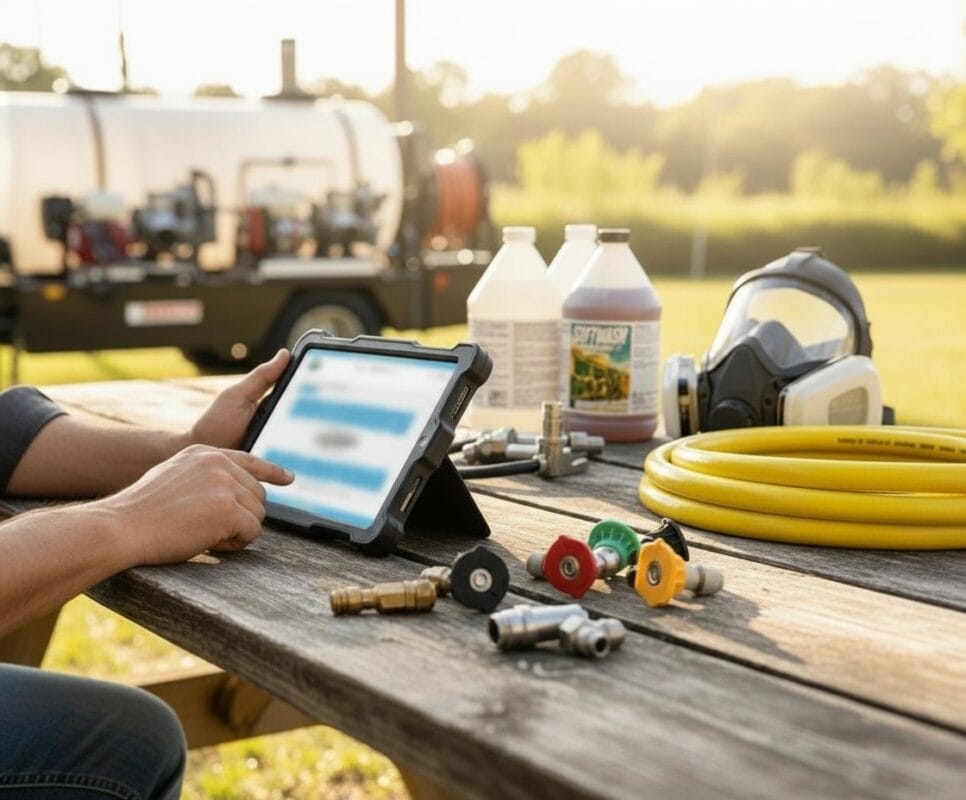Sodium Hypochlorite 101: Guide for Soft Washing Professionals
- Posted by: Collin Steele
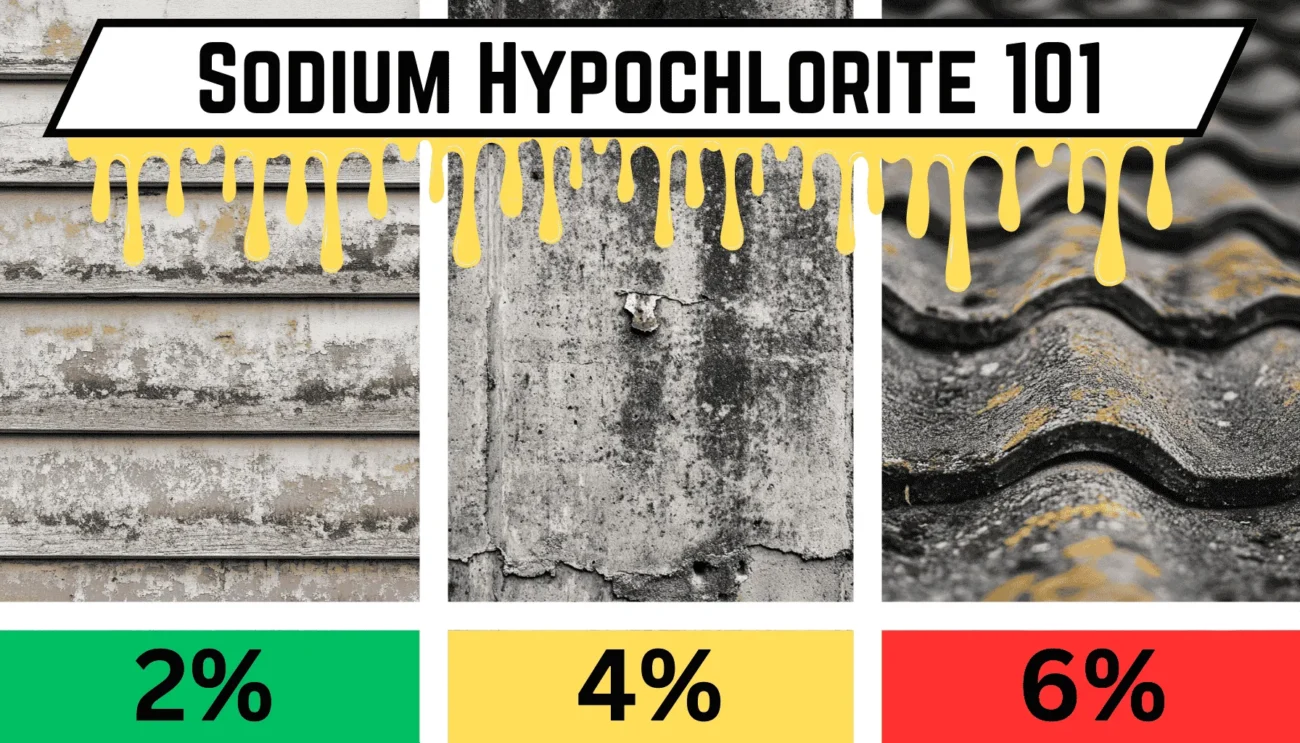
Introduction
In the world of exterior cleaning, sodium hypochlorite (SH) stands out as a powerhouse chemical. It’s the unsung hero behind those sparkling clean surfaces, effectively eliminating stubborn organic stains and contaminants. But what exactly is SH, and how can soft washing professionals harness its full potential while ensuring safety and environmental responsibility?
This comprehensive guide dives deep into everything you need to know about sodium hypochlorite. From its chemical properties and history to best practices and what percentage SH to use on different surfaces. Whether you’re a seasoned professional or new to the industry, this article will equip you with the knowledge to use SH effectively and responsibly.
Understanding Sodium Hypochlorite
What is Sodium Hypochlorite (SH)?
Sodium hypochlorite (NaOCl) is a chemical compound composed of sodium (Na), oxygen (O), and chlorine (Cl). Commonly known as bleach or chlorine bleach, SH is a clear, slightly yellowish solution with a characteristic odor. It’s widely used for its disinfecting, bleaching, and oxidizing properties.

At its core, SH is a powerful oxidizing agent. This means it can accept electrons from other substances during a chemical reaction, effectively breaking down organic materials.
History and Place in the Periodic Table
Discovered in 1789 by French chemist Claude Louis Berthollet, sodium hypochlorite has a rich history in sanitation and cleaning. Berthollet produced it by passing chlorine gas through a solution of sodium carbonate, creating a substance that could bleach fabrics.
SH isn’t an element but a compound of elements with unique and highly effective cleaning properties.
How SH Works
Sodium hypochlorite works by oxidizing organic materials. When applied to a surface, it reacts with organic compounds, breaking their chemical bonds. This process effectively kills microorganisms like bacteria, viruses, fungi, and algae.

The oxidation reaction disrupts essential cellular processes in these organisms, leading to their death and removal from the surface. This makes SH particularly effective in eliminating mold, mildew, and algae that can mar the appearance of exterior surfaces.
The Role of SH in Soft Washing
Why SH is Effective in Soft Washing
Soft washing relies on chemical action rather than high-pressure water to clean surfaces. Sodium hypochlorite is ideal for this method due to its strong oxidizing properties, which eliminate organic growth, restore surface appearance, and provide long-lasting cleanliness.
Combining SH with surfactants enhances its effectiveness. Surfactants help SH stick to sloped or vertical surfaces, increasing dwell time and effectiveness. They also enable the solution to penetrate tiny crevices and porous materials where organic matter may hide.
One product we recommend is the Mango Mauler Surfactant. It’s specially formulated to work with SH, improving adherence and cleaning power!
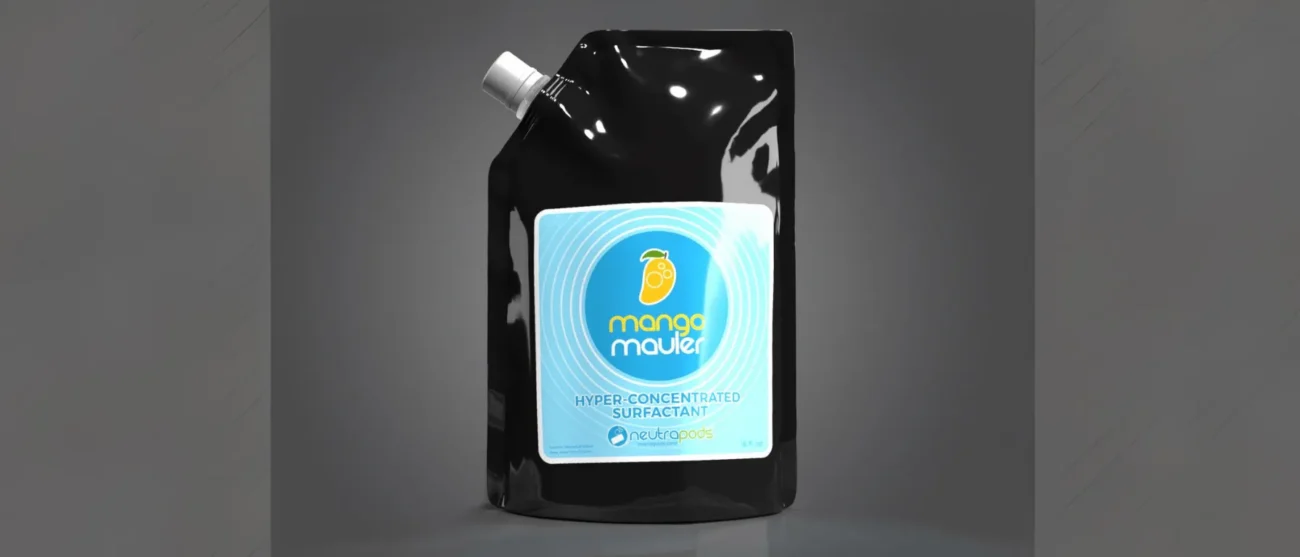
For more information on soft washing best practices, check out our Softwashing Tips.
Recommended SH Concentrations for Different Surfaces
Using the correct SH concentration is crucial to achieving optimal results without damaging surfaces. Here’s a guideline:
- Low Concentration (1-2% SH): Suitable for vinyl siding, painted surfaces, wood siding, windows, and frames. This concentration is ideal for delicate surfaces where strong chemicals might cause damage.
- Medium Concentration (2-4% SH): Suitable for stucco, concrete, brick, masonry, gutters, and downspouts. It’s effective for moderate organic growth and more robust surfaces.
- High Concentration (3-6% SH): Suitable for asphalt shingle roofs, clay tile roofs, heavily soiled concrete, and areas with severe organic growth. This strength is necessary for tough stains and significant mold or algae presence.
Remember to always adjust concentrations based on the specific conditions of the job and test on a small area first.
Handling and Storage of Sodium Hypochlorite
Safety Precautions
Handling sodium hypochlorite requires strict safety measures due to its corrosive nature.
Personal Protective Equipment (PPE) is essential:
- Respiratory Protection: Use a respirator specifically designed for chemical fumes. We recommend our Soft Wash Respirator, which provides excellent protection and comfort.
- Eye Protection: Wear safety goggles or a full-face shield to protect against splashes.
- Skin Protection: Use chemical-resistant gloves and wear long sleeves and pants to prevent skin contact.

Always avoid direct contact with SH, and work in well-ventilated areas to prevent inhalation of fumes. Never eat, drink, or smoke when handling SH.
Proper Storage Practices
To maintain the effectiveness of SH and ensure safety, proper storage is crucial.
Storage Conditions:
- Temperature: When not in use, store SH in a cool, dark place, ideally between 50-70°F. Higher temperatures accelerate degradation, reducing potency. If storing outside in the heat, it’s recommended to use SH within 2-3 weeks of purchase for optimal cleaning power.
- Light Exposure: Protect from sunlight to prevent accelerated degradation.
- Ventilation: Ensure storage areas are well-ventilated to prevent the buildup of toxic fumes.
Best Materials for Storage Tanks:
- High-Density Polyethylene (HDPE) is resistant to SH and commonly recommended and available for storage. Opaque white HDPE tanks are ideal as they reflect sunlight, keeping SH cooler while minimizing UV penetration. Black tanks block UV light but absorb heat, which can increase SH degradation.

Bulk Purchasing:
Sodium hypochlorite is typically sold in bulk by pressure washing equipment suppliers at strengths of either 12.5% or 10%. Bulk pricing runs about $2-$3 per gallon, making it cost-effective for large-scale operations.
Mixing and Application Techniques
Batch Mixing, Proportioning, and Downstreaming
Choosing the right mixing and application method can improve efficiency and effectiveness.
Batch Mixing
Batch mixing involves mixing a specific amount of SH and water in a tank before application.
Process:
- Measure and add SH to the tank.
- Add water to achieve the desired concentration.
- Mix thoroughly.
Advantages:
- Flexibility to adjust concentrations for different jobs.
- Simple equipment requirements.
Considerations:
- Requires accurate measurements.
- Potential waste if the mix isn’t fully used.
To help with accurate measurements, you can use online tools like the Soft Wash Batch Mix Calculator.
Proportioning
Proportioning uses equipment to mix SH and water on-demand during application.
Process:
- SH and water are stored separately.
- A proportioner draws and mixes them at preset ratios as you work.
Advantages:
- Consistent mix ratios.
- Reduces waste and saves time.
We offer a reliable Soft Wash Proportioner that can enhance your efficiency and consistency.
For more details, read our article on What is a Softwash Proportioner and How is it Used?.
Downstreaming
Downstreaming is a method where SH is injected into the water stream after the pump.
Process:
- Use a downstream injector or XJet Nozzle attached to the pressure washer.
- SH is drawn from a container and mixed with water after it exits the pump.
Advantages:
- Protects the pump from corrosive SH.
- Allows for easy switching between soft wash and rinse modes.
Considerations:
- Limited to lower concentrations due to dilution rates.
- Maximum SH strength is about 4.8% when using an XJet Nozzle.
The XJet Nozzle is a popular tool for downstreaming. It allows for higher chemical draw rates and better reach without exposing the pump to SH.

Environmental and Safety Considerations
Understanding SH Hazards
Awareness of SH’s hazards is crucial for safe use. SH can cause severe skin and eye irritation, and mixing it with acids releases toxic chlorine gas.
Emergency Procedures:
- Skin Contact: Rinse immediately with plenty of water.
- Eye Contact: Flush eyes with water for at least 15 minutes and seek medical attention.
- Inhalation: Move to fresh air and seek medical help if symptoms persist.
Protecting Surfaces and Materials
Preventing damage ensures customer satisfaction and preserves materials. Not all surfaces are suitable for cleaning with SH.
Identify Sensitive Surfaces:
- Avoid using SH on metals prone to corrosion.
- Be cautious with painted surfaces and natural stone.
- Galvalume roofing should not be treated with SH, as it can cause significant damage.
Application Techniques:
- Use lower concentrations where appropriate.
- Employ proper rinsing methods.
- Use barriers or coverings to protect nearby areas.
Neutralizing SH After Use
Neutralization protects plants, surfaces, and the environment. It prevents damage from residual SH and reduces environmental impact.
We recommend using Neutrapods. They’re easy to use and effectively neutralize SH after cleaning.
Application Steps:
- Apply the neutralizer after cleaning is complete.
- Follow manufacturer instructions for dilution and application.
- Ensure thorough coverage of affected areas.
For a real-life example of the dangers, read our article Softwash Nightmare.

FAQs from Soft Washing Service Providers
Can SH be used on all surfaces?
No, SH should not be used on certain materials, including Galvalume roofing, delicate fabrics, and some types of wood. Always test on a small area and consult manufacturer recommendations.
How does temperature affect SH effectiveness?
Higher temperatures accelerate SH degradation, reducing its potency. It’s best to store and use SH at cooler temperatures and protect it from direct sunlight.
What substances should not be mixed with SH?
SH should never be mixed with ammonia or ammonia compounds, acids (like vinegar or hydrochloric acid), hydrogen peroxide, or organic solvents. Mixing can produce dangerous gasses or reactions.
Best Practices for Soft Washing Professionals
Employee and Customer Education
Educated teams and informed customers contribute to successful operations.
Employee Training:
Regular safety training on handling SH is essential. Ensure your team knows how to use personal protective equipment and understands emergency procedures.
Customer Communication:
Be transparent with your customers. Explain the benefits and safety measures of using SH, address any concerns about environmental impact or property safety, and provide pre- and post-service instructions.

Proper Disposal of SH
Responsible disposal protects the environment and complies with regulations.
Disposal Guidelines:
- Neutralize leftover SH before disposal.
- Do not pour undiluted SH into drains or sewers.
- Follow local regulations for hazardous waste.
Conclusion
Sodium hypochlorite is an indispensable tool for soft washing professionals. Its ability to eliminate organic growth and restore surfaces is unmatched when used correctly. By understanding its properties, handling it safely, and applying it effectively, you can provide exceptional service while safeguarding yourself, your clients, and the environment.
Embrace best practices, stay informed about new developments, and continue to refine your techniques. Your commitment to excellence not only enhances your reputation but also contributes to the overall advancement of the soft washing industry.
Next Steps
Elevate your soft washing services with the right tools and products. Protect yourself with our Soft Wash Respirator, achieve precise mixing with our Soft Wash Proportioner, and enhance your cleaning power with the Mango Mauler Surfactant. Don’t forget to neutralize SH safely after use with Neutrapods.
For more information, training opportunities, or to explore our full range of products, contact us today.
Additional Resources
Related Articles:
Industry Links and References:
Latest Blog Posts
If you’ve been soft washing for a while, or even if you’re just starting out, you’ve probably heard the word
...